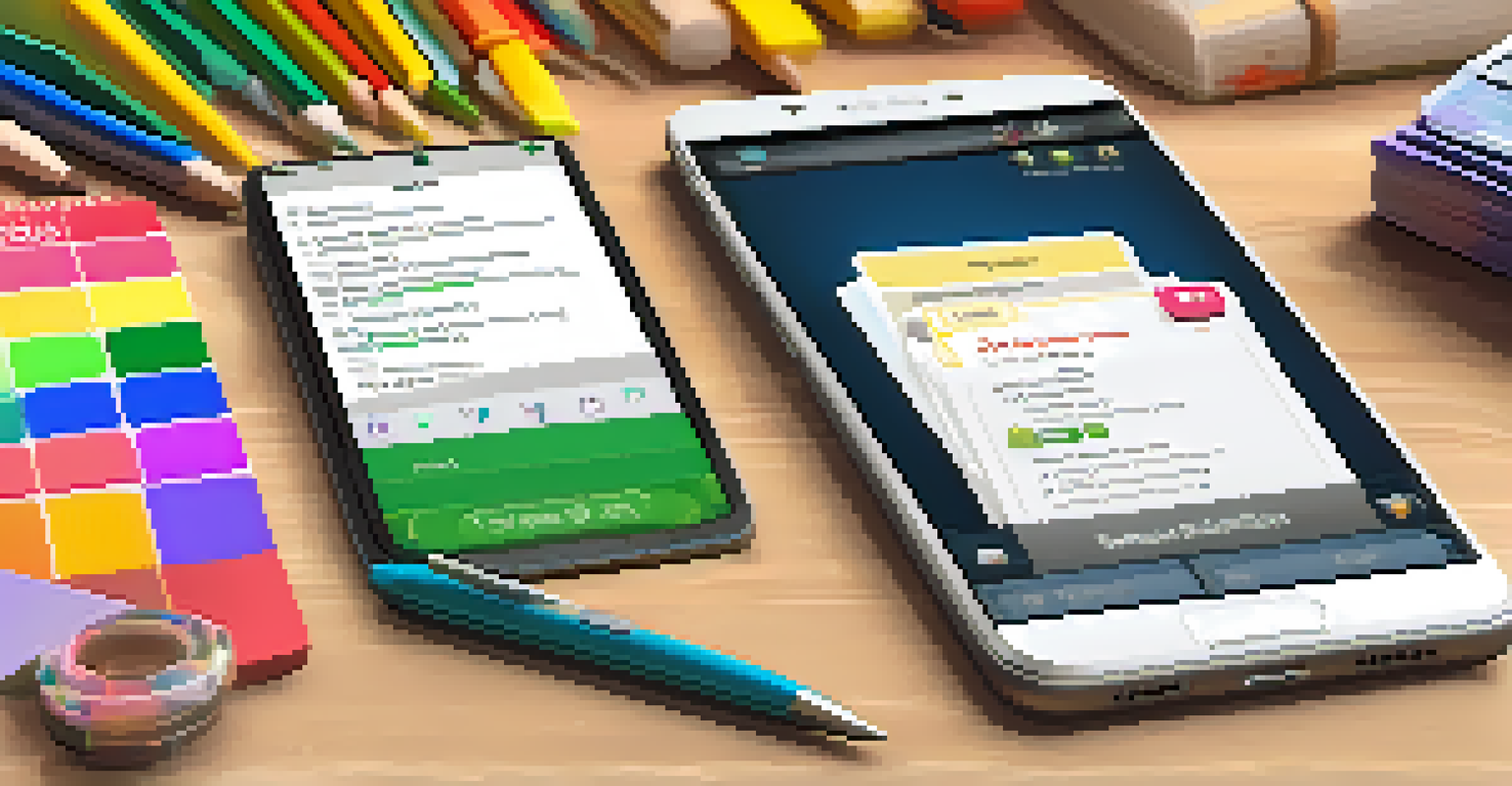Mobile Learning for Language Acquisition: Tools and Techniques

Understanding Mobile Learning in Language Acquisition
Mobile learning, often referred to as m-learning, leverages mobile devices to facilitate learning anytime, anywhere. This approach is especially beneficial in language acquisition, as it allows learners to engage with the language in real-world contexts. Whether it's through apps or online resources, m-learning enhances accessibility and flexibility for language learners.
Mobile learning provides the flexibility and accessibility needed for language learners to engage with new languages anytime, anywhere.
Imagine being able to practice your language skills during your daily commute or while waiting in line. Mobile learning transforms downtime into productive learning opportunities, making it easier to fit language study into a busy schedule. This adaptability is crucial for learners who may struggle to find dedicated study time.
Additionally, mobile learning can provide instant feedback, which is essential for language development. Many applications offer quizzes and exercises that allow learners to gauge their progress immediately, reinforcing their learning experience and encouraging them to continue.
Popular Mobile Learning Apps for Language Acquisition
There are numerous mobile apps designed specifically for language learners, each offering unique features. Duolingo, for instance, gamifies the learning experience with bite-sized lessons that make studying feel like a fun challenge. Users can track their progress and even compete with friends, adding a social element to learning.

Another popular option is Babbel, which focuses on conversation skills and practical phrases. Its lessons are tailored to real-life situations, helping learners gain confidence in speaking from the very beginning. This practical approach is particularly useful for those who are preparing for travel or business trips.
Mobile Learning Enhances Accessibility
Mobile learning allows language learners to study anytime and anywhere, fitting seamlessly into busy schedules.
Lastly, Memrise employs spaced repetition and mnemonic techniques to help learners remember vocabulary effectively. By using these scientifically-backed methods, Memrise ensures that users retain what they learn over the long term, making it a valuable tool in any language learner's toolkit.
Techniques to Enhance Mobile Learning Effectiveness
To maximize the effectiveness of mobile learning, it's important to incorporate specific techniques tailored to language acquisition. One effective strategy is to set clear, attainable goals. By establishing daily or weekly targets, learners can maintain motivation and track their progress over time.
The future of education is mobile, and it brings the classroom to our pockets, allowing us to learn at our own pace.
Another technique is to immerse oneself in the language as much as possible. This could involve listening to podcasts, watching films, or reading ebooks in the target language. The more exposure learners have, the more natural the language will become, and mobile devices make accessing this content easier than ever.
Lastly, engaging with native speakers through language exchange apps can significantly enhance the learning experience. Platforms like Tandem and HelloTalk connect learners with native speakers for conversational practice, allowing them to apply their skills in real-world interactions.
Creating a Routine for Mobile Learning Success
Establishing a consistent routine is key to success in mobile learning. By dedicating specific times each day for language practice, learners can create a habit that becomes part of their daily lives. Even just 10-15 minutes a day can lead to substantial progress over time.
Incorporating a variety of activities into the routine can also keep things fresh and engaging. For example, a learner could alternate between vocabulary practice, grammar exercises, and listening activities throughout the week. This diversity not only maintains interest but also reinforces different aspects of language acquisition.
Engagement Boosts Language Retention
Using interactive apps and connecting with native speakers through social platforms significantly enhances language acquisition.
Moreover, tracking progress can be immensely motivating. Many language learning apps offer built-in tracking features, allowing users to visualize their achievements and stay committed to their goals. Celebrating small milestones can boost confidence and encourage continued learning.
Overcoming Common Challenges in Mobile Learning
While mobile learning offers significant benefits, it also comes with challenges. One common issue is the potential for distractions from notifications and social media. To combat this, learners can set specific times for focused study sessions, turning off notifications to create a distraction-free environment.
Another challenge is the temptation to skip lessons or procrastinate. To address this, learners should remind themselves of their goals and the reasons they started learning in the first place. Keeping motivation high can be as simple as revisiting inspiring content or connecting with fellow learners.
Lastly, it’s important to acknowledge that language learning is a journey that requires patience. Setbacks are normal, and using mobile tools can help learners stay on track. By viewing challenges as opportunities for growth, learners can maintain a positive mindset throughout their language acquisition process.
Integrating Social Learning into Mobile Language Acquisition
Social learning is an essential component of language acquisition, and mobile platforms facilitate this interaction seamlessly. Language exchange apps allow learners to connect with speakers from around the world, fostering a community where learners can practice and support each other. This social aspect adds a layer of accountability and encouragement.
Moreover, social media platforms can also serve as tools for language learning. Joining groups or following pages dedicated to language tips can provide valuable resources and expose learners to authentic language use. Engaging with content in the target language, such as memes or articles, can make learning feel more relatable.
Future Innovations in Mobile Learning
The integration of AI and AR technologies promises to make mobile language learning even more personalized and effective.
Finally, participating in online challenges, like the popular '30-day language challenge,' can create a sense of camaraderie among learners. Sharing progress and experiences on social media can motivate individuals to stay committed to their learning journey and celebrate achievements together.
The Future of Mobile Learning in Language Acquisition
As technology continues to evolve, so too will the tools available for mobile learning in language acquisition. Innovations like augmented reality (AR) and artificial intelligence (AI) are set to enhance the learning experience, making it even more interactive and personalized. Imagine using AR to practice vocabulary in real-world settings through your device's camera!
AI-driven language apps are also becoming more sophisticated, offering tailored lessons based on individual learning styles and progress. These advancements can make language learning more efficient and effective, allowing learners to focus on areas where they need the most improvement.

Looking ahead, the integration of mobile learning into educational systems is likely to grow. Schools and institutions are beginning to recognize the importance of mobile tools in language education, paving the way for a more flexible and inclusive learning environment. The future of language acquisition is bright, with mobile learning at the forefront of this evolution.